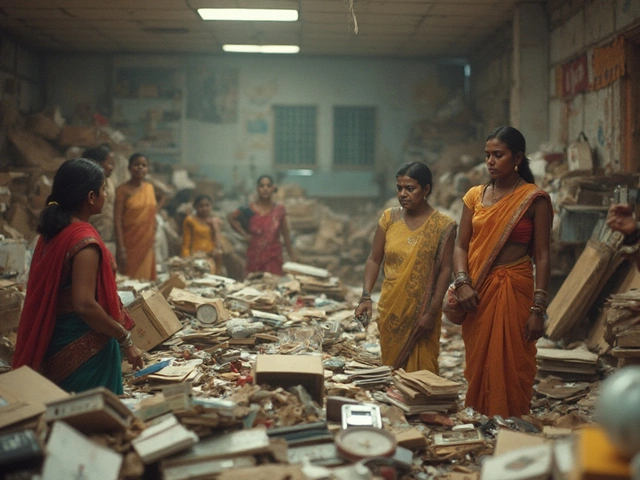Ever been at a fundraiser and wondered which causes actually rake in the most donations? You’re not alone. Every year, millions pour cash, time, and stuff into charity events—but where does all that generosity really end up? Some causes, like medical research or disaster relief, usually get the lion’s share, but there’s more to it than just following the crowd.
If you’re looking to support a charity or run a fundraiser, knowing what others are passionate about can help you make a bigger impact. Trends change, but some causes keep topping the donation lists for a reason. Figuring out the why behind those choices can help you connect with donors—and maybe even help a cause that doesn’t always get the spotlight.
- The Top Causes People Support
- Why Certain Causes Get More Donations
- New Trends in Giving
- How Events Influence Where We Give
- Tips for Boosting Donations at Your Event
The Top Causes People Support
When it comes to charity donations, some causes just do better than others. Year after year, certain issues strike a chord and bring in big support—at local events, online fundraisers, and even spur-of-the-moment giving.
Here’s a quick look at the areas where people tend to focus their charity donations the most:
- Health and Medical Research: Think cancer funds, heart disease, children’s hospitals. Big charity runs and galas for these causes raise billions every year.
- Disaster Relief: When hurricanes, earthquakes, or wildfires hit, people give fast. Relief-focused charities see massive spikes after major disasters.
- Children’s Services: Programs for education, child hunger, and kids with disabilities pull at people’s heartstrings and bring steady support.
- Animal Welfare: Animal shelters and rescue organizations receive a surprising amount of love, especially in local communities.
- Hunger and Homelessness: Food banks and shelters are high on people’s minds, especially during the holidays.
Take a look at how people in the U.S. split up their donations in 2023 according to Giving USA:
| Cause | Percentage of Total Donations |
|---|---|
| Religious Organizations | 27% |
| Education | 15% |
| Human Services (Food, Shelter) | 13% |
| Health Organizations | 10% |
| Public Benefit (civil rights, community) | 9% |
| International Affairs | 6% |
| Animal Welfare & Environment | 4% |
| Arts, Culture, Humanities | 4% |
Religious groups—like churches and faith-based charities—still get the single biggest chunk. But you can see health, education, and basic human needs make up a huge piece too. People usually give to causes they feel a personal connection with, whether it’s helping their own community or showing support after crises they see in the news.
Why Certain Causes Get More Donations
There’s a reason you always see huge checks going to children’s hospitals or relief efforts after a natural disaster. Big events with lots of media coverage tug at people’s emotions and make them want to help out instantly. When stories hit the news—think hurricanes, earthquakes, or viral charity campaigns—donations spike fast, even from people who don’t usually give.
Personal connections play a huge role too. If someone’s family has been affected by cancer, for example, they’re a lot more likely to give to cancer research. The ALS Ice Bucket Challenge back in 2014 proved just how far this can go—it raised over $115 million in just a few months because almost everyone knew someone touched by the disease, or they simply got caught up in the fun videos.
Trust also matters. Big, well-known organizations usually get more because they’re seen as safe bets. People want to be sure their money lands where it’s supposed to—so they stick with names they recognize. According to Giving USA’s latest report, over 60% of donations in the U.S. still go toward religious groups, education, and human services, because these causes have built a reputation for making a real difference.
Don’t underestimate the power of peer pressure, either. When friends share their donations on social media, or when workplaces set up matching campaigns, people tend to follow along. Charities that make giving easy—one-click online payments, simple donation links at charity events—see a lot more money come in, just because they’ve cut out all the hassle.
- If a cause hits close to home, people give more.
- The bigger and more trusted the charity, the safer donors feel.
- When giving is fun or social (think challenges or community events), numbers go way up.
- Causes that make the news see serious spikes in donations, even if just for a little while.
So when you see one cause always leading the pack, it’s usually about timing, trust, and how easy it is for people to get involved.

New Trends in Giving
Things have shifted a lot in the charity world over the last few years. People aren’t just dropping money in a bucket anymore—they want their charity donations to feel personal and make an obvious impact. One big trend? Crowdfunding. Platforms like GoFundMe and Givebutter have turned personal stories into powerful fundraising tools. You see a family hit by a house fire or a neighbor raising money for surgery—suddenly, you know exactly who your donation is helping.
Another noticeable trend is the rise of monthly giving programs. Instead of one-off handouts, supporters are signing up to donate small amounts every month. Nonprofits love this because it means a steady income, and it also helps them plan projects in advance. For donors, it’s hands-off—set it and forget it, but still make a difference.
Eco-friendly and sustainability causes are also getting more attention than ever. Gen Z and millennials especially aren’t just throwing cash at any charity—they want to support organizations tackling climate change, plastic waste, and animal protection. In 2023, Nature Conservancy and clean water projects were among the fastest-growing recipients of online donations.
You’ve probably noticed another trend tied to events: giving gets more digital every year. Charity streams on Twitch and YouTube are pulling in millions, thanks to gamers and influencers rallying their audiences around donation goals. Digital wallets like PayPal, Venmo, and Apple Pay make it ridiculously fast to send money—no more excuses like, 'I forgot my checkbook.'
One last note: people are moving away from supporting massive organizations and leaning toward smaller, local groups where they can see real impact. Micro-giving—where you round up purchases or throw in a couple bucks at checkout—has exploded, especially with apps plugging donation buttons into nearly every transaction. So if you want to tap into the biggest charity donations trends, think personal, digital, and local first.
How Events Influence Where We Give
If you’ve ever felt more generous at a charity dinner or while scrolling through a livestream fundraiser, you’re in good company. The type and vibe of an event has a huge impact on the causes folks decide to donate to. Simple truth: people open their wallets wider when they feel a real connection—and events are designed to pull those heartstrings.
Let’s get concrete. At big galas for cancer research, donors are often moved by patient stories or by meeting survivors in person. Online challenges, like those viral ice bucket videos, made ALS donations jump from $2.8 million in 2013 to $115 million the year after. Why? Because seeing thousands of friends, celebs, and influencers get involved turns curiosity into action. Getting swept up in the moment isn’t just a cliché; it’s how our brains work. If you see everyone else getting involved, you’re way more likely to chip in too.
Different events pull in different crowds, and that shapes where all that support ends up. Check out how the type of event matches the usual causes:
| Event Type | Typical Causes Supported | Average Donation Range (USD) |
|---|---|---|
| Black-tie Gala | Medical Research, Arts, Education | 500 - 5000+ |
| Charity Run/Walk | Health Awareness, Community Projects | 30 - 150 |
| Online Fundraiser | Disaster Relief, Individual GoFundMe cases | 10 - 200 |
| Benefit Concert | Children’s Charities, Environmental Causes | 50 - 500 |
| School-Affiliated Event | Education, Youth Groups | 15 - 250 |
Here’s where it gets interesting for charity organizers. Did you know that matching gift challenges at events can boost total donations by up to 50%? People love the idea that their cash will be doubled on the spot. If you’re planning your own event, adding a live thermometer (tracking money raised in real time) amps up energy—those little wins keep everyone giving.
And don’t overlook social proof. When events call out donors by name or showcase leaderboards, it taps into a basic urge to join the crowd. Combining these tricks with the right kind of event can shift what charity donations go to the most popular—and sometimes, under-the-radar—causes.

Tips for Boosting Donations at Your Event
If you’re hoping to raise the most for your cause, the way you set up your event matters more than you might think. Timing, clear messaging, and a few clever moves can mean a lot more cash for your charity. Here’s what actually helps:
- Tell a clear story—People give more when they know exactly where their money's going. Spell it out with real stories or photos showing the impact. Stats say around 68% of people are more likely to donate if they see how their gift helps someone directly.
- Make it easy—If folks can donate online with a few clicks, they're way more likely to do it. QR codes on tables or during speeches? Super effective. Charity Navigator reports that events with text-to-donate options raise up to 30% more than those without.
- Create friendly competition—Silent auctions, donation leaderboards, or matching gift challenges work because people love a bit of rivalry and seeing progress live. One nonprofit boosted event giving by 42% just by showing a donation thermometer in real time.
- Give something back—Even small tokens like a digital thank-you, a free drink, or a shout-out on social media make donors feel good. Thanking folks right away helps them remember the event—and you—next time.
- Tap into local pride—Mentioning community impact can boost giving. When people see money stays local, they're up to 50% more likely to chip in, according to the Lilly Family School of Philanthropy.
If you want to see how these tactics stack up, here's a quick look at which methods bring in the most at charity donations events:
| Fundraising Method | Average Donation Increase |
|---|---|
| Text-to-Donate | +30% |
| Donation Thermometer/Live Updates | +42% |
| Matching Gift Challenges | +22% |
| Personal Stories/Impact Photos | +68% likelihood to give |
| Community-Focused Messaging | +50% likelihood to give |
You don’t have to do all of this—just picking two or three tweaks can move the needle. And don’t forget: friendly follow-up after the event (a group photo, a quick “look what we did!” email) keeps people coming back for more next year.



